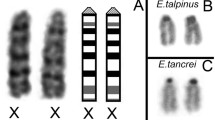Summary
Sex in the woodlouseArmadillidium nasatum ordinarily is determined by a gonosomal mechanism, the male being heterogametic. In a special strain, this mechanism is modified by autosomal female-determining factors which accumulated up to a certain quantity make an XY-individual develop into a female, against its gonosomal sex. A female of this kind produces an offspring with 1 ♀:3 ♂♂ sex ratio, one third of the males bearing two Y and therefore generating arrhenogenic offspring, i.e. consisting of males only. In contrary to a normal family (“family” means the whole inbreeding descendance over some generations originating from one female) the distribution of the sexes in the family of a female out of the arrhenogenic strain does no more show any relation to the ratio 1:1. The reason is discussed why a genetic system leading to aberrant sex-relations is maintained beside a gonosomal mechanism. The advantage of a high female rate for propagation seems to be at least one of the reasons. A high number of females can be advantageous as the lack of males is compensated by concentration of the animals and by the ability of the females to store sperms.
Similar content being viewed by others
Literatur
Anders, A., u.F. Anders: Genetisch bedingte XX- und XY-♀♀ und XY- und YY-♂♂ beim wildenPlatypoecilus maculatus aus Mexiko. Z. Vererbungsl.94, 1–18 (1963).
Anders, F.: Über die geschlechtsbeeinflussende Wirkung von Farballelen beiGammarus pulex ssp.subterraneus (Schneider). Z. indukt. Abstamm.- u. Vererb.-Lehre88, 291–332 (1957).
Becker-Carus, C.: Der Einfluß der Tageslänge auf die Ausbildung des Geschlechts beiArmadillidium vulgare (Crust. Isop.) (Experimentelle Verschiebung des Geschlechtsverhältnisses). Verh. Dtsch. Zool. Ges., Jena 1965 (im Druck).
Heilbronn, A., u.C. Kosswig: Principia genetica. Grunderkenntnisse und Grundbegriffe der Vererbungswissenschaft. Hamburg u. Berlin: Paul Parey 1961.
Howard, H. W.: The genetics ofArmadillidium vulgare Latr., II. Studies on the inheritance of monogeny and amphogeny. J. Genet.44, 143–159 (1942).
—: The genetics ofArmadillidium vulgare Latr., IV. Lines breeding true for amphogeny and thelygeny. J. Genet.56, 1–10 (1958).
Johnson, G.: Contribution à l'étude de la détermination du sexe chez les oniscoides: phénomènes d'hermaphroditisme et de monogénie. Bull. biol. France Belg.95, 177–272 (1961).
Kosswig, C.: Polygene Geschlechtsbestimmung. Naturw. Rdsch.18, 392–401 (1965).
—, u.M. Öktay: Die Geschlechtsbestimmung bei den Xiphophorini (Neue Tatsachen und neue Deutungen). Istanbul Üniv. Fen Fak. Hidrob. B2, 133–156 (1955).
Lattin, G. de: Über die Bestimmung und Vererbung des Geschlechts einiger Oniscoideen (Crust., Isop.) I. Untersuchungen über die geschlechtsbeeinflussende Wirkung von Farbfaktoren beiPorcellio undTracheoniscus. Z. indukt. Abstamm.- u. Vererb.-Lehre84, 1–37 (1951).
—: Über die Bestimmung und Vererbung des Geschlechts einiger Oniscoideen, (Crust. Isop.) II. Zur Vererbung der Monogenie vonCylisticus convexus (DEG.). Z. indukt. Abstamm.-u. Vererb.-Lehre84, 536–567 (1952).
—: Vererbungsstudien an Isopoden. I. Zur Genetik der Farbvariabilität vonCylisticus convexus (Deg.). Zool. Anz.160, 313–324 (1958).
Lueken, W.: Über Geschlechtsbestimmung bei Landisopoden. Z. wiss. Zool.166, 252–352 (1962).
—: Zur Spermienspeicherung bei Armadillidien (Isopoda terrestria). Crustaceana5, 27–34 (1963).
Öktay, M.: Weitere Untersuchungen über eine Ausnahme (XX)-Sippe desPlatypoecilus maculatus mit polygener Geschlechtsbestimmung. Istanbul Üniv. Fen Fak. Mecm. B24, 225–233 (1959).
Peters, G.: Vergleichende Untersuchungen an drei Subspecies vonXiphophorus helleri Heckel (Pisces). Z. zool. Syst. Evolut.-Forsch.2, 185–271 (1964).
Schmölzer, K.: Beitrag zur Kenntnis der GattungArmadillidium Latr. 1804 (Isopoda terrestria). Acta zool. fenn.80, 1–63 (1954).
Seitz, I.: Über die Vererbung und Differenzierung des Geschlechts beiAsellus aquaticus L.Diss. Mainz 1954.
Shaw, R. F.: The theoretical genetics of the sex ratio. Genetics43, 149–163 (1958).
Shaw, R. F., andJ. D. Mohler: The selective significance of the sex ratio. Amer. Natural.87, 337–342 (1953).
Teichmann, H.: Chromosomenstudien an Isopoden unter besonderer Berücksichtigung der Oniscoidea. Mitt. Hamburg. Zool. Mus. Inst.60, 1–42 (1962).
Tinturier-Hamelin, E.: Polychromatisme et détermination génétique du sexe chez l'espèce polytypiqueIdotea balthica (Pallas) (Isopode valvifère). Cah. Biol. mar.4, 473–591 (1963).
Traut, W.: Zur Geschlechtsbestimmung beiGammarus duebeni Lillj. und verwandten Arten (Crustacea, Amphipoda). Z. wiss. Zool.167, 1–72 (1962).
Vandel, A.: Recherches sur la génétique et la sexualité des isopodes terrestres, VI. Les phénomènes de monogénie chez les oniscoides. Bull. biol. France Belg.75, 316–363 (1941a).
—: Recherches sur la génétique et la sexualité des isopodes terrestres, VII. Sur la longévité des spermatozoides à l'intérieur de l'ovaire d'Armadillidium vulgare. Bull. biol. France Belg.75, 364–368 (1941b).
—: Recherches sur la génétique et la sexualité des isopodes terrestres, IX. Recherches de génétique sur quelques oniscoides. Bull. biol. France Belg.79, 168–216 (1945).
Vitagliano-Tadini, G.: La variabilità del rapporto sessi inAsellus aquaticus e la sua determinazione oligogenica. Atti Accad. naz. Lincei34, Ser. VIII, 573–582 (1963).
Winge, Ö.: The experimental alternation of sex-chromosomes into autosomes and vice versa, as illustrated byLebistes. C. R. Trav. Lab. Carlsberg, Sér. phys.21, 1–49 (1934).
Zander, C. D.: Die Geschlechtsbestimmung beiXiphophorus montezumae cortezi Rosen (Pisces). Z. Vererbungsl.96, 128–141 (1965).
Author information
Authors and Affiliations
Rights and permissions
About this article
Cite this article
Lueken, W. Autosomale weibchendeterminierende Realisatoren beiArmadillidium nasatum (Isopoda terrestria) . Zeitschrift für Vererbungslehre 97, 345–352 (1966). https://doi.org/10.1007/BF00902277
Received:
Issue Date:
DOI: https://doi.org/10.1007/BF00902277




